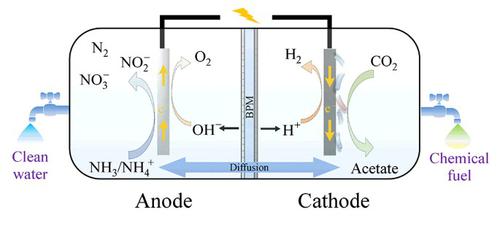Frontiers of Environmental Science & Engineering ( IF 6.1 ) Pub Date : 2021-07-15 , DOI: 10.1007/s11783-021-1476-5 Qinjun Liang 1 , Yu Gao 1 , Zhigang Li 1 , Jiayi Cai 1 , Na Chu 1 , Yong Jiang 1 , Raymond Jianxiong Zeng 1 , Wen Hao 2

|
Microbial electrosynthesis (MES) is an emerging technology for producing chemicals, and coupling MES to anodic waste oxidation can simultaneously increase the competitiveness and allow additional functions to be explored. In this study, MES was used for the simultaneous removal of ammonia from synthetic urine and production of acetate from CO2. Using graphite anode, 83.2%±5.3% ammonia removal and 28.4%±9.9% total nitrogen removal was achieved, with an energy consumption of 1.32 kWh/g N for total nitrogen removal, 0.45 kWh/g N for ammonia nitrogen removal, and 0.044 kWh/g for acetate production. Using boron-doped diamond (BDD) anode, 70.9%±12.1% ammonia removal and 51.5%±11.8% total nitrogen removal was obtained, with an energy consumption of 0.84 kWh/g N for total nitrogen removal, 0.61 kWh/g N for ammonia nitrogen removal, and 0.043 kWh/g for acetate production. A difference in nitrate accumulation explained the difference of total nitrogen removal efficiencies. Transport of ammonia and acetate across the membrane deteriorated the performance of MES. These results are important for the development of novel electricity-driven technologies for chemical production and pollution removal.
中文翻译:

微生物电合成系统中的电驱动氨氧化和乙酸盐生产
微生物电合成 (MES) 是一种新兴的化学品生产技术,将 MES 与阳极废物氧化结合可以同时提高竞争力并探索其他功能。在本研究中,MES 用于同时去除合成尿中的氨和从 CO 2 中生产醋酸盐. 采用石墨阳极,氨氮去除率83.2%±5.3%,总氮去除率28.4%±9.9%,总氮去除能耗1.32 kWh/g N,氨氮去除能耗0.45 kWh/g N,0.044用于醋酸盐生产的千瓦时/克。使用掺硼金刚石(BDD)阳极,氨去除率为70.9%±12.1%,总氮去除率为51.5%±11.8%,总氮去除能耗为0.84 kWh/g N,总氮去除能耗为0.61 kWh/g N。氨氮去除,醋酸生产0.043 kWh/g。硝酸盐积累的差异解释了总氮去除效率的差异。氨和乙酸盐跨膜的传输降低了 MES 的性能。这些结果对于开发用于化学品生产和污染清除的新型电力驱动技术具有重要意义。











































 京公网安备 11010802027423号
京公网安备 11010802027423号